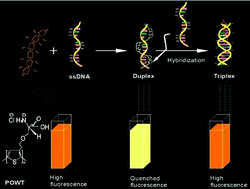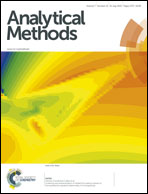Sensitive and fluorescence “turn-on” detection of BRCA1 and TB4 DNA sequences using water-soluble conjugated polythiophenes†
Abstract
A biocompatible, label-free and sensitive fluorescence “turn-on” approach was designed to detect BRCA1 and TB4 DNA sequences using poly(3-[(S)-5-amino-5-carboxyl-3-oxapentyl]-2,5-thiophenylene hydrochloride) (POWT). The fluorescence intensity of POWT in solution could be efficiently quenched by adding either BRCA1 or TB4 DNA sequences. The Stern–Volmer equation was used to fit the quenching effect and the LOD could thus be obtained. The fluorescence would recover its initial intensity after the addition of completely complementary ssDNA, but not with sequences with 1–3 mismatched bases. The influences of buffer pH and buffer composition were investigated systematically in order to improve the sensitivity of this fluorescent probe. For the BRCA1 DNA sequence, the KSV (Stern–Volmer constant) and LOD were 8.254 × 109 M−1 and 2.231 × 10−12 M, respectively. For the TB4 DNA sequence, the KSV and LOD were 6.924 × 109 M−1 and 2.659 × 10−12 M, respectively. In addition, the quantitative linearity range for detecting these two DNA sequences was from 1 × 10−11 M to 5 × 10−11 M, and the response time for the quenching effect was less than 10 minutes for both sequences. Hence, with fine biocompatibility, high sensitivity, fast response and high recovery rate, a serine functionalized POWT might be a promising candidate for detecting the BRCA1 DNA sequence and TB4 DNA sequence as well as their mutations, which might possibly be applied to clinical diagnosis of breast cancer or ovarian tumours.


 Please wait while we load your content...
Please wait while we load your content...